South Korea’s Political and Economic Miracles and Christian Influence
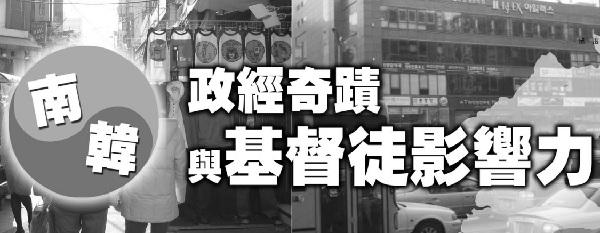
Since the 1960s, South Korea, Taiwan, Singapore and Hong Kong have all imitated Japan's policy of expanding exports, and their economies have grown rapidly. Before 1960, the per capita national income of these four places was comparable to that of Africa and South Asia, which were the poorest countries at the time. However, between 1989 and 1995, the per capita national income exceeded US$10,000 and was classified as an advanced high-income country by the World Bank and the United Nations.
In 1993, the World Bank also published the book "The East Asian Miracle", affirming that the economies of South Korea, Taiwan, Singapore and Hong Kong are not only developing rapidly and increasing per capita income, but also attaching great importance to income distribution and striving to narrow the gap between rich and poor, and are moving towards a "Great Harmony World" state, and its economic development model has also become a model for other developing countries to learn from. 11
Except for Hong Kong, which is a free trade zone and the government rarely intervenes in the economy, Japan and the other three countries (South Korea, Taiwan, and New Zealand) have strongly dominated and guided domestic industries in the process of economic development, making their countries move in the direction that the government deems most beneficial. . The development of high-tech industries in South Korea and Taiwan is the result of government promotion, which has created the leading position of South Korea and Taiwan in high-tech industries today.
In response to the focus of this issue, this article intends to first analyze the trends and challenges faced by South Korea's rapid economic and trade development, and point out the correlation between South Korea's rapid emergence from the political and economic crisis and the rapid growth of the church, and then analyze the country's Christians' views on South Korea. Regarding the possible impact of future political and economic developments, I hope to encourage each other with churches and Christian leaders from all walks of life. In addition, among the Four Asian Tigers, Hong Kong and Singapore are small island economies, while South Korea and Taiwan are the most similar. Therefore, this article also appropriately compares the economic development of South Korea and Taiwan.
The gap between the two countries on the Korean Peninsula
The Korean Peninsula was divided into two countries after World War II: the Democratic People's Republic of Korea (North Korea) and the Republic of Korea (South Korea). North Korea occupies 121,000 square kilometers and South Korea 98,500 square kilometers. Even though countries such as China, Vietnam, and the former Soviet Union have changed course and carried out capitalist-style economic reforms, which have greatly improved the economies and people's living standards in various countries, North Korea and a few countries (such as Cuba and Myanmar) still resolutely implement socialism. , leaving North Korea’s 23.5 million people still trapped in extreme poverty, with the per capita national income in 2007 being only US$1,900.
South Korea's land area is smaller than that of North Korea, but its population is more than double that of North Korea (49.2 million). Thanks to the efforts of all citizens, the economy has grown rapidly since the war (especially after the 1960s), and national income and living standards have increased significantly. Together with Taiwan, Hong Kong, and Singapore, they are known as the "Four East Asian Tigers" and have transformed from poor and backward countries. (In 1960, the per capita national income was less than 100 US dollars) By 1995, it became a high-income country in the world.
Politically, South Korea has also made significant progress: from 1952 to 1988, the South Korean government was ruled by the military; in 1988, a democratic movement took place to amend the constitution; in 1992, democratically elected presidents began, making South Korea a multi-party democracy.
Economic situation in South Korea and Taiwan
South Korea's land area is 2.7 times that of Taiwan, and its population is 2.2 times that of Taiwan (according to 2008 data, 49.23 million versus 22.98 million). Both have dense populations and land for manufacturing. In terms of economic development, from the early days of development, most of the Korean business world was monopolized by large companies, while Taiwan was dominated by small and medium-sized enterprises (many family consortiums have also emerged in recent years). Therefore, before 2000, Taiwan's economic development and political stability were roughly the same. has always been ahead of South Korea.
After the change of power in Taiwan in 2000, the new government lacked experience and adopted a seclusion policy towards China. It also had poor economic management and fierce political party fighting. Its performance in many aspects of economic development began to lag behind that of South Korea. 22
In 1982, South Korea became the world's 15th largest exporter (Taiwan ranked 14th). In the mid-1990s, South Korea officially joined the club of advanced countries, the Organization for Economic Cooperation and Development (OECD). Although the Asian financial crisis in 1997 put South Korea's economy into trouble, fortunately, it dealt with it appropriately and quickly recovered, its economy climbed, and it became an industrialized country dominated by high-tech production.
The following is the national income data of South Korea in the past two years: 33
*Per capita gross national income: In 2006, it was US$17,690, ranking 51st among the 210 countries in the world (Taiwan ranked 52nd with US$16,036); in 2007, it was estimated to be US$19,220, and by 2008 it would be nearly $20,000.
*Gross national income (or gross national product): In 2006, it was US$856.5 billion, ranking 12th in the world, even lower than India and Brazil (China ranked 4th, and Taiwan ranked 21st with US$393.8 billion).
When the Asian Financial Crisis broke out in 1997, South Korea was the first to bear the brunt. It suffered a massive loss of foreign exchange reserves and the rapid depreciation of the Korean Won, forcing it to seek assistance from the International Monetary Fund. As a result, the economic growth rate dropped by 7% in 1998, which was unprecedented. Per capita income dropped from US$12,190 in 1997 to US$9,200 in 1998~1999. However, South Korea's economy has rebounded rapidly since 2000, and its per capita income was on par with Taiwan in 2005 and began to lead Taiwan in 2006 (see the comparison between Figures 1 and 2)4.4.
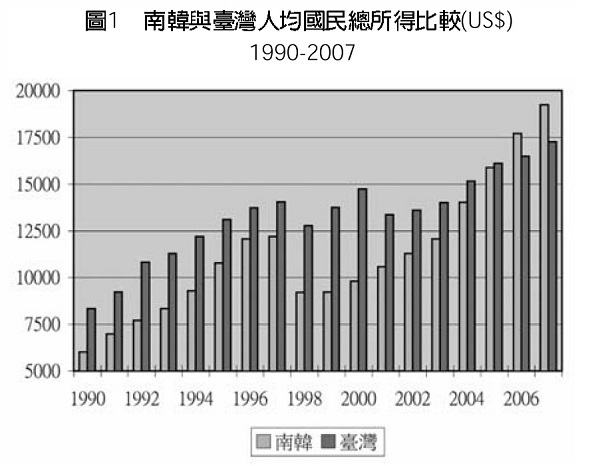
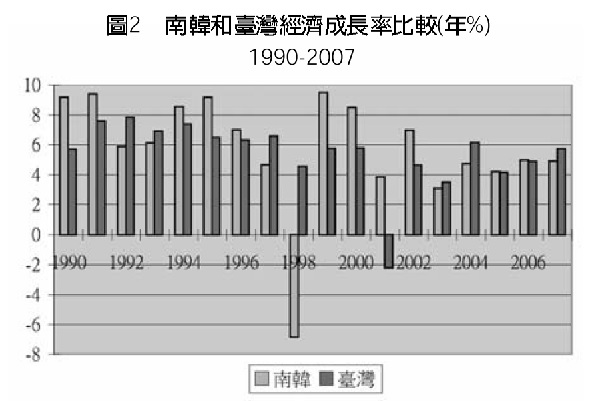
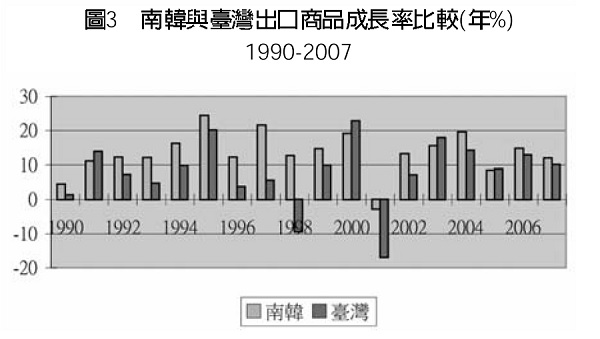
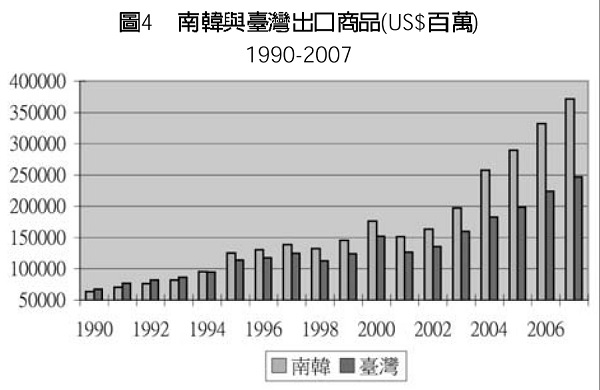
Amazing export growth rate
Over the years, the growth rates and numerical performance of South Korea and Taiwan's export trade have been very impressive (see the comparison between Figures 3 and 4). However, South Korea has surpassed Taiwan since 1994 because its growth rate has been higher than that of Taiwan over the years. This is related to the fact that at that time, the mainland was reforming and opening up, and various countries were vying to invest and set up factories in the mainland, but Taiwan gradually adopted a lock-down policy (the government called on Taiwanese businessmen not to go to the mainland), and the cross-strait situation gradually cooled down.
In 2006, South Korea's export value reached US$332 billion, making it the 11th largest exporting country in the world (Germany, the United States, China, and Japan ranked 1st to 4th respectively; Hong Kong and Taiwan ranked 12th and 16th respectively). The main factors causing the substantial increase in South Korea's exports are the rise of the Chinese market and the large number of Korean businessmen investing in China. From 1998 to 2006, South Korea's exports to China and bilateral trade increased sixfold respectively. China surpassed the United States as the country with the largest exports. The main export items are intermediate products, such as semiconductors, computer parts, semi-finished products and manufactured goods. Finished product.
In the past four years, South Korea's export growth rate has exceeded 10% each year. Since 1990, South Korea's manufacturing industry has gradually shifted from "low value-added" industries such as textiles to "high value-added" industries such as automobiles, shipbuilding and electronic products. South Korea currently has the top three shipbuilding companies in the world, ranks third in the world in steel production, and ranks sixth in the automobile industry. In addition, South Korea is a world leader in the electronics industry such as memories, mobile phones, and liquid crystal screens (LCDs).
Exports of high value-added products account for 50% of total exports. The proportion of South Korea's high-tech product exports in manufacturing exports has increased from less than 15% in 1990 to more than 30% year by year since 1999. This shows South Korea's efforts in high-tech products. The performance of South Korea's shipbuilding industry is outstanding. In 2000, it surpassed Japan and became the country with the highest shipbuilding output in the world. Ship exports accounted for 7% of total exports. Since 2004, the annual shipbuilding export growth rate has been 25%. Currently, new shipbuilding orders account for 40% of the world's total, with China and Japan each receiving 25%.
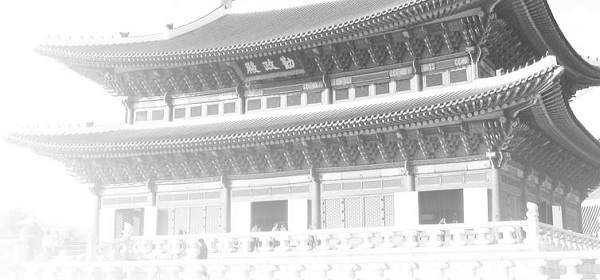
Challenges and Adaptations
However, rapid progress and growth have also brought unfavorable factors. For example, the Korean won's real exchange rate has appreciated by 20% since the end of 2004, and the inflation rate has remained relatively high. Coupled with the rise of China's economy and trade, the global competitiveness of Korean industries has declined, and they are facing China. , competition from Japan and other trading partners (the biggest impact is on the electronics and automobile industries), as well as the Korean won's appreciation faster than the Japanese yen, which has depressed the profits of Korean manufacturers and other issues. 55
In the face of competition, South Korea, like Taiwan, must respond to economic policies, such as strengthening research and development, improving product quality and added value, changing industrial structure, etc. Looking back on the many challenges South Korea faced in the past, especially the 1997 financial crisis, it was able to turn crises into opportunities. I believe South Korea's economy can still move forward to join the ranks of advanced European and American countries.
South Korea's economy has been able to turn the corner, restart and grow rapidly, and its political system has also changed from military rule to a pluralistic democratic system. The reason behind this may be related to the rapid increase in the number of Christians in the country. When we look back at the modern industrial revolution, we can see that the advanced countries, with the exception of Japan, are all Christian countries (Japan’s Meiji Restoration also learned from British laws and regulations). Below we analyze the possible influence of Christians on Korean politics and economy.
The church is growing rapidly
South Korea is one of the countries with the fastest growing churches and has the highest percentage of Christians in Asia. According to the census data of the South Korean government, the proportion of Christians in the total population: 20.7% in 1985; rose to 26.3% in 1995 (a total of 11.2 million, including 19.7% for Protestants, 6.6% for Catholics; 23.2% for Buddhists, and no 49.3% of Faith). The proportion of Christians in 2005 was 29.2%, of which 10.9% were Catholics and 18.31% were Protestants (see Table 1).
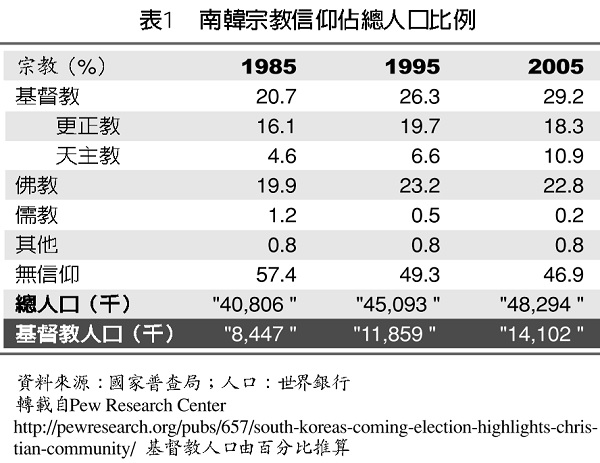
However, according to statistics from the book "Operation World", the proportion of Christians in South Korea in 2000 was approximately 31.7% of the total population, approximately 14.8 million people. Table 2 is the book’s statistics on religious beliefs in South Korea in 2000. It may be a more reliable and detailed statistics.
過去對南韓基督徒人數的估計因為沒有考慮雙重會籍的問題(以更正教與獨立教派之間的情況最多),因此可能高估。6值得華人教會效法的是,韓國差派出非常多宣教士到海外宣教,2000年估計就有一萬兩千人分佈在一百五十六個國家(資料來源如表2)。
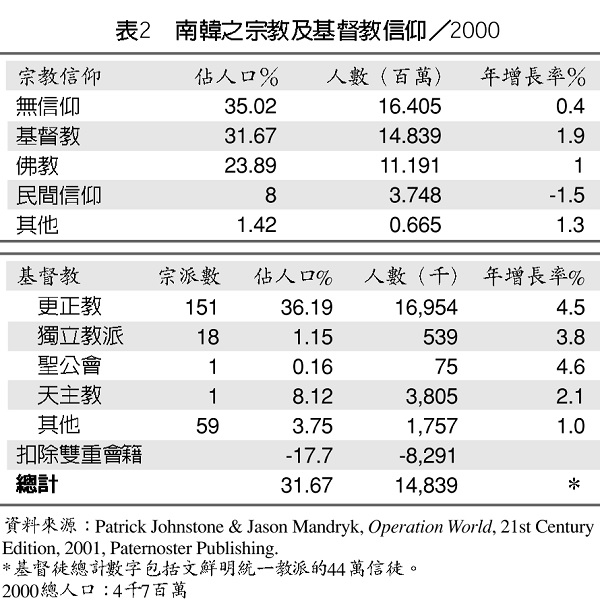
又據另一份資料,2005年韓國已有一千九百萬基督徒(佔總人口39.3%),會員超過一萬人的大教會有十五間。7這數字和上述2000年的宣教士資料較為相關。不論採用哪種數據,我們都可以說,目前南韓基督徒佔總人口比例30%以上,約在一千五百萬至兩千萬之間。
Faith brings strength
The increase in the Christian population obviously has a positive impact on politics and social atmosphere. In particular, Korean believers are highly obedient to pastors and elders and are diligent in prayer. In the presidential election in December 2007, the new president Lee Myung-bak won. Some say it was because of the support of Christians, who accounted for 30% of the country's population, because he is an elder of Somang Presbyterian Church, one of the largest churches in South Korea. �篞|Christians also make up the majority of members of the parliament and can influence various policies.
In addition to their political and social influence, Korean Christians also play an important role in companies. According to a survey, the bosses of the top ten companies in South Korea are all Christians. The survey also found that half of Christians believe that political and social issues should be concerned, and two-thirds of Christians believe that political leaders should have firm beliefs. 88
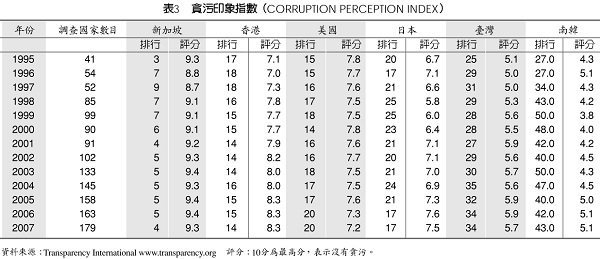
Eliminate corruption
However, some people question that although there are many Christians, their influence is not as great as claimed because corruption is prevalent in South Korea. When South Korea began to democratize in the 1980s, several democratically elected presidents themselves or their children were sentenced for corruption. Roh Tae-woo was the first directly elected president (term 1988-1993); his successor Kim Young-sam (1993-1998) called for the eradication of corruption. In August 1996, the court sentenced Roh to prison for bribery. Former President Chun Doo-hwan (1980~1988) was also sentenced for launching a coup and bloody suppression of demonstrations and riots from 1979 to 1980.
However, Kim Young-sam allowed the arbitrary expansion of chaebols in the economy. The corruption culture of corporate bribery of officials and the prevalence of bank lending led to the financial crisis in 1997. In the last few weeks of his administration, he was forced to request a bailout from the International Monetary Fund and other institutions. 580 billion, and his son was also arrested and imprisoned on corruption charges. His successor, Kim Dae-jung (1998∼2003), was the first dissident to be elected president in South Korea. He won the Nobel Peace Prize for promoting the policy of liberation from North Korea. However, in his last year in power, he was criticized by public opinion due to corporate scandals. A son was also sentenced for bribery and tax evasion.
Roh Moo-hyun (2003~2008) had inappropriate economic policies, which caused the Korean economy to lag behind during his administration. However, public opinion believes that he made a contribution to getting rid of money politics and establishing a transparent system. Although the new President Lee Myung-bak is a Christian, he has also been questioned about his moral integrity (investment misconduct). Although the court later cleared him, Koreans still have doubts about him.
Korea in transformation
"Transparency International" began conducting the Corruption Perception Index (CPI) survey in 1995. The countries surveyed ranged from 41 countries in 1995 to 179 countries in 2007, covering almost all countries in the world. Table 3 lists the CPI rankings of several relevant countries, including Singapore, Hong Kong, the United States, Japan, Taiwan, and South Korea in order.
Among the above-mentioned countries, South Korea has the most severe corruption. In 1995, South Korea's CPI index ranked 27th among 41 countries, falling behind half of the countries. After 1998, the ranking has been between 43 and 50. In the most recent survey in 2007, South Korea ranked 43 among 179 countries, still lagging behind Taiwan and even further behind Singapore, the leading corruption-free country. However, since 2005, corruption in South Korea seems to have begun to improve significantly (see score column), which may be related to President Roh Moo-hyun's new policies and the influence of Christians.
Another Bribe Payers Index (BPI) from Transparency International refers to the extent to which companies in exporting countries bribe officials overseas, especially in developing countries, to obtain export benefits. The Bribery Index surveyed 21 exporting countries in 2002. The bottom four countries were Russia (21, the worst), China, Taiwan and South Korea, indicating that companies in these countries paid bribes to foreign countries to obtain export benefits. The situation is the most serious.
The 2006 Bribery Index surveyed 30 exporting countries. The countries with the worst bribery image were India (30, the worst), China, Russia, Turkey and Taiwan (26), but South Korea has improved to 21st. There is still a long way to go compared to the clean countries Japan (11) and Singapore (12), but it has got rid of the image of the worst countries.
Let us humbly review
The improvement in the rankings of the corruption index and bribery index may be related to the continued increase in the Christian population, but it is also related to the country becoming a pluralistic democratic country (for example, Japan and Taiwan are non-Christian countries, but they are ranked before South Korea; the United States is a Christian country, but the ranking is not after Hong Kong). However, the author believes that the supervision mechanism of democratic politics coupled with the rapidly increasing Christian population can make a country progress faster in all aspects. South Korea's corruption index currently lags behind Taiwan's, but given time, it is believed that it will improve significantly due to the positive influence of Christians.
Seeing the rapid increase in the Christian population in South Korea and the renaissance of sending missionaries overseas on a large scale, the Christian population in Taiwan has always been hovering around 3%. In addition to humbly reviewing and sincerely learning from the Koreans, the Chinese church must also serve Taiwan (and mainland China) pray from many sources. Because from the political and economic development of South Korea, we see the unchanging theorem:
“Blessed is this people who have the Lord as their God!” (See Psalm 144:15)
Notes
Figure 1-5 Source: Taiwan: Taiwan Government Statistics; South Korea: World Bank website.
1.World Bank (1993): The East Asian Miracle: Economic Growth and Public Policy (World Bank Policy Research Reports), Oxford University Press, 1993.
2. South Korea’s economic achievements today are largely related to the government’s early active cultivation of “chaebols”. A handful of chaebols have long monopolized the country's economy. In 1995, the four largest chaebols in the country were: Hyundai Group, Samsung Group, Daewoo Group and Lexi Venus Group. However, after the Asian financial crisis in 1997, on the one hand, due to the government-led reforms, the chaebols lost their original reliance; on the other hand, the death of the old chaebol leaders and family discord caused internal divisions in the chaebol families, resulting in the chaebol group The power is gradually weakening. In 2003, only 4 of the original 18 chaebols remained, but they still dominate South Korea's economic development (see online Wikipedia information, "Korean Economy - Chaebols" column zh.wikipedia.org). However, what is very interesting is that in the later stages of Taiwan's economic development, several family businesses similar to those of Korean chaebols emerged. They grew in size and gradually dominated Taiwan's economic development.
3. Source of statistical data for this article─South Korea: Based on the World Bank, International Monetary Fund, US Central Intelligence Agency (CIA), and South Korean government websites. Taiwan: Government-related websites, US CIA, International Monetary Fund website.
4. The terms used in this article: Gross National Income (GNI-Gross National Income) refers to the total domestic and foreign income of the people of a country in a year, or Gross National Product (GNP-Gross National Product). Gross Domestic Product (GDP-Gross Domestic Product) refers to domestic production, excluding net income from foreign factors. There is usually not much difference between GNI (or GNP) and GDP. For the convenience of international comparison, GNI or GDP is usually converted into US dollars, usually using the official exchange rate. However, taking into account price changes, the purchasing power of each country is converted based on U.S. prices, which becomes GNI or GDP calculated based on purchasing power parity (PPP-Purchasing Power Parity). Due to the different PPP bases, the values calculated by PPP will differ internationally. Since South Korea's inflation is higher than Taiwan's, even if the per capita GNI or GDP calculated using the foreign exchange rate has exceeded Taiwan's, Taiwan's per capita income calculated using PPP is still higher than South Korea. For example, in 2007, the International Monetary Fund estimated that Taiwan's per capita GDP based on purchasing power parity was US$30,126, ranking 28th in the world, while South Korea was US$24,783, ranking 35th. The per capita GDP calculated at the official exchange rate is US$16,790 in Taiwan and US$19,751 in South Korea (the figures may vary due to different data sources).
5. The appreciation of the domestic currency is detrimental to exporters because the value of exchanging foreign currency back into the domestic currency decreases.
6. This statistics seems to be similar to that of 1985, but the statistics of 2000 exclude the population with dual membership (17.7%), and the data of 1985 does not take into account the issue of dual membership. It may be an overestimation, so it is not included. in this article.
7. Michelle Vu, S. Korea Presidential Election Highlights Christian Influence, Christian Post, 12/13/2007. http://www.christianpost.com/article/20071213/30491_S._Korea_Presidential_Election _Highlights_Christian_Influence.htm8. Ibid.
8.同上註。
 Author profile
Author profile
Wen Yingqian is currently a professor in the Department of Economics at National Dong Hwa University in Hualien, Taiwan; a retired senior economic expert from the World Bank.
